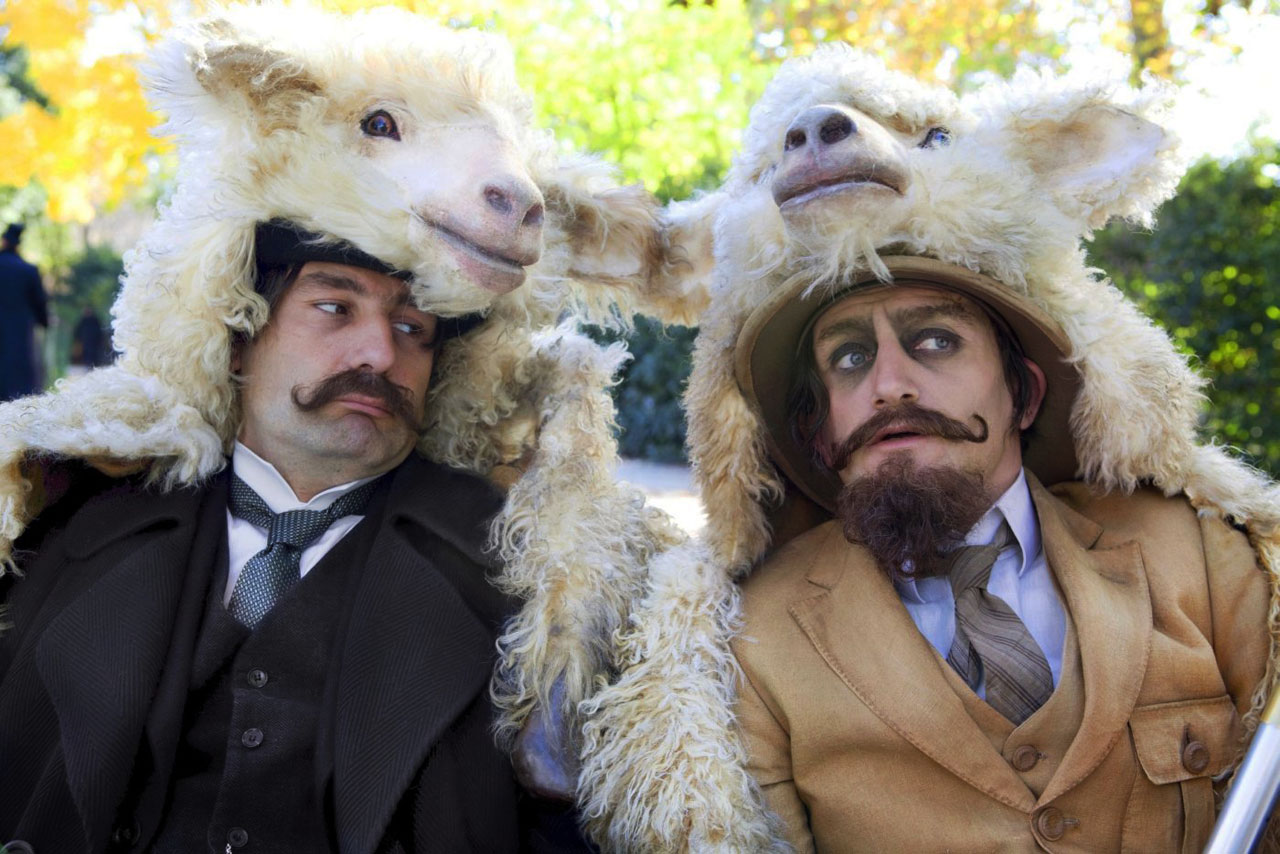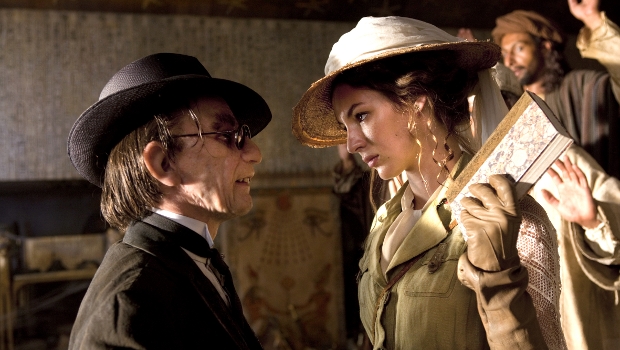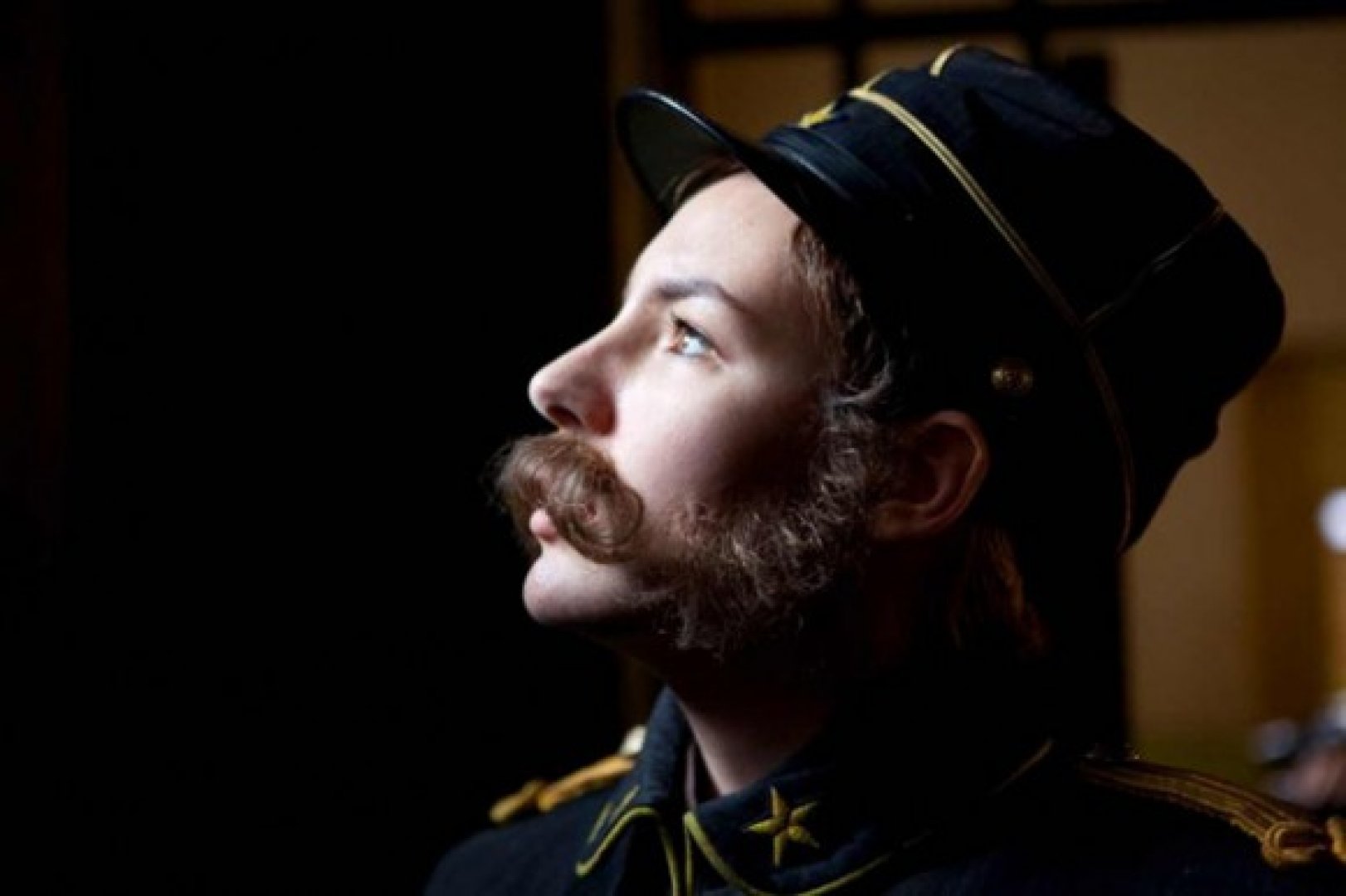Readers may be familiar with director Luc Besson’s previous work, which includes the excellent films like The Fifth Element (1997), Leon the Professional (1994; featuring a quite young Natalie Portman), or the lesser-known, but personal favorite, Unleashed (2005; featuring Jet Li, Morgan Freeman, and the late Bob Hoskins). These are wildly different films, but they are a testament to Besson’s versatility as a writer and director. The Extraordinary Adventures of Adèle Blanc-Sec (Les aventures extraordinaires d’Adèle Blanc-Sec; 2010), seems, then, to be a departure from what has come before, in no small part because this is a film which is coded for a younger audience by its humor and delivery. In that respect, it is a fun, if not somewhat uneven adventure comedy.
 EAABS is based on a historical fantasy comic by Jacques Tardi (released in 1976). Though perhaps less well known in the U.S., Tardi’s work is well regarded, especially in Europe, where he has been nominated for or won such accolades as the Eisner and the Grand Prix de la ville d’Angouleme, the highest honor in France for comics.* As I haven’t read the comics myself, I can’t say whether this follows any particular set of narratives originally put on the page by Tardi. Set in the late 1800s, the film follows the titular Adele Blanc-Sec (Louise Bourgoin) as she travels far and wide in search of ancient treasures and knowledge. In this first film in a proposed trilogy, Adele seeks the mummified remains of Patmosis (Regis Royer), who she believes served as Ramses II’s physician and may hold the key to solve her sister’s medical condition. But as with all her adventures, this one is full of hiccups, from backstabbing hired hands to the villainous — and quite ugly — Dieuleveult (Mathieu Amalric — one hell of a disguise). Meanwhile, back in Paris, Le professeur Menard, whom Adele needs to awaken Patmosis, conducts a strange ritual which awakens a baby pterodactyl from its egg. But the Paris authorities are none to happy about that and sentence Menard to death for the murders committed by the beast, leaving Adele, upon her return, no choice but to find a way to save Menard from certain death.
EAABS is based on a historical fantasy comic by Jacques Tardi (released in 1976). Though perhaps less well known in the U.S., Tardi’s work is well regarded, especially in Europe, where he has been nominated for or won such accolades as the Eisner and the Grand Prix de la ville d’Angouleme, the highest honor in France for comics.* As I haven’t read the comics myself, I can’t say whether this follows any particular set of narratives originally put on the page by Tardi. Set in the late 1800s, the film follows the titular Adele Blanc-Sec (Louise Bourgoin) as she travels far and wide in search of ancient treasures and knowledge. In this first film in a proposed trilogy, Adele seeks the mummified remains of Patmosis (Regis Royer), who she believes served as Ramses II’s physician and may hold the key to solve her sister’s medical condition. But as with all her adventures, this one is full of hiccups, from backstabbing hired hands to the villainous — and quite ugly — Dieuleveult (Mathieu Amalric — one hell of a disguise). Meanwhile, back in Paris, Le professeur Menard, whom Adele needs to awaken Patmosis, conducts a strange ritual which awakens a baby pterodactyl from its egg. But the Paris authorities are none to happy about that and sentence Menard to death for the murders committed by the beast, leaving Adele, upon her return, no choice but to find a way to save Menard from certain death.
As a film, EAABS seems to court an comedic style fit for a younger audience. Most of the secondary characters are quirky and bumbling, from Inspecteur Albert Caponi (Gilles Lellouche), who spends most of the film falling asleep or having his meals interrupted by “official business,” to Andrej Zborowski (Nicolas Giraud), a young scientist who nervously tries to court Adele Blanc-Sec, to Justin de Saint-Hubert (Jean-Paul Rouve), a big game hunter hired by the president of France to hunt down the pterodactyl (he always seems to be one step behind his prey). Though I personally enjoy the quirky caricatures that sometimes populate films like this, I do find that there is a tendency to overindulge, as is true here. The problem with so many caricatures is that so few of them show any real development as people. Menard, for example, is presented as a joyful spirit with a somewhat childish air, but the conclusion of his narrative doesn’t change anything for his character. The same is true of Caponi, who is once against interrupted from his meal at the end of the film, and most of the other characters in the film aside from Andrej — who receives some small and relatively insignificant growth — and Adele — who is much the same as Andrej, despite being the title character. Though the humor is, at times, quite amusing — I personally enjoyed Caponi’s desperation to get a sandwich — it ultimately draws away from characters themselves.
All of this goes to the tonal quality of this film: it is a silly movie that seems consistent with something along the lines of Spy Kids — lots of childish humor and caricatures within a fantastic setting — but with humor that seems designed for an older audience. Dieuleveult, for example, is in no way coded as “just gross”; his grossness rests on his innuendo-laced dialogue with Adele and his unwanted sexual advances. Unlike Andrej, whose stuttering presence indicates an innocent, almost childish romantic love, Dieuleveult is always already the predator, from the distorted monstrosity of his facial features to his smile, his dialogue, and body language. This is certainly not the thing one would expect of a movie for kids. EAABS maintains this tone throughout, taking otherwise graphic content and funneling it through its almost slapstick humor. Even Menard’s death sentence receives similar treatment — he is literally taken to the guillotine and almost beheaded, and yet this is supposed to be a silly, funny moment where his rescue by Adele on the back of the pterodactyl will be just this side of adorable.
None of this is to suggest that the film falls flat on its face. Though the film only courts its gender politics in a subdued manner, there is a clear sense here that Adele is a woman ahead of her time. She is determined, mostly capable (except when she tries to break Menard out of prison using various disguises), quick-witted, and intelligent (often times more so than her male counterparts). This is all established beautifully in the opening scenes, where she comes face-to-face with a world of men who view her female-ness as a marker of her lack of knowledge — an irony that she shoves back in their faces. Even as men pursue her romantically (or sexually), Adele is often too much for them, because she defies the convention of a swooning maiden who is easily dispatched by romantic letters and flowers or a woman easily flustered by depraved behavior.** In a largely sexist society, Adele is played as utterly unafraid to rock convention. In that respect, Louise Bourgoin is a solid casting choice.
There are also some subtle jabs at French exceptionalism here, particularly in the figure of Justin de Saint-Hubert, whose skill as a big game hunter (presumably in French colonial territory) gives him the position as de facto representative of France. That his mind is so focused on the conquest that he can’t even see the carpet being pulled out from under him (or behind him) seems to undermine the staunch patriotism exhibited by the government — by comparison, Adele is utterly disinterested. The film’s anachronisms are also amusing. The mummies all speak French and mostly adhere to 19th century notions of manners. Why? Probably out of convenience for the narrative, but it does provide a shocking “am I dreaming” moment for Adele, who realizes that she’s having a conversation with a mummy who isn’t speaking ancient Egyptian. But this also affords some rather adorable dialogue, especially in the concluding scenes, wherein Ramses II and his mummy entourage head off into the night in search of Cairo; before they leave, they admire the architecture, to which Ramses II responds, “maybe we should build a pyramid here.” I certainly chuckled at that.
EAABS is also a testament to the importance of the “less is more” mantra. Here, the budget is obviously quite small by comparison to other adventure narratives (25mil Euros, I think), yet there is nary a wasted dime on mountains of subpar effects. Most of the film relies on grounding its characters in the real, using prosthetics or excellent costume design to draw the audience’s attention to the realistic details. When EAABS does indulge in CG, it is in small doses. There are even clever uses of blurred background effects to avoid the obvious lack of high quality effects (by Hollywood blockbuster standards). This is a clever way to avoid the problem of uprooting an audience from the cinematic fantasy. The focus remains on keeping this world feeling like the 1890s — at least, as much as is possible.***
Overall, this is far from a perfect film, but it does have a lot to offer in terms of its adventure — sort of like a female Indiana Jones, if one were to make a not-quite-accurate comparison. I mostly enjoyed the experience and would like to see Besson continue the story with more of Adele’s adventures, especially given the final scene, which sets up a “secret history” narrative for a major historical nautical event. Besson may need to work on character development in the future, but this is a solid first run. Hopefully, we’ll see more of Adele Blanc-Sec in the near future (and more of Louise Bourgoin).
Directing: 3/5
Cast: 3.5/5
Writing: 3/5
Visuals: 3.5/5
Adaptation: N/A (I haven’t read the comics)
Overall: 3.25/5 (65%)
Inflated Grade: B (for a fun and sometimes humorous adventure story featuring a strong female heroine)
Value: $7.00 (based on $10.50 max)
——————————————–
*Thanks to my friend, Aaron, for helping me put Tardi’s various awards in context, as I’m not an expert on comics, let alone French comics.
**There is nothing wrong with liking these things, of course. Adele’s sister is quite the opposite in this regard.
***History buffs will surely see inaccuracies here. I, however, did not.
———————————————
A (World) SFF Film Odyssey is an extension of my personal mission to watch and review every science fiction and fantasy film released in 2010. All of the non-US titles will be reviewed/discussed/maimed on the Skiffy and Fanty blog as part of the World SF Tour. The full list of titles (w/ links to posts) can be found here. You can find out more about this project here.











